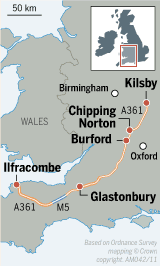Postcard from ... Devon

Simply sign up to the Life & Arts myFT Digest -- delivered directly to your inbox.
Why has America cornered the market in road trips? The circuits of New England, the drive up the California coast and – above all – Route 66 have captured the imaginations of generations of motorists. But as millions of Britons take to the roads this bank holiday weekend, they will mostly do so with a sense of weary resignation rather than of romance.
The time has come to reclaim Britain’s roads – and one road in particular. While nobody is likely to write a song about getting their kicks on the A361, this epic but obscure highway (beloved of a small band of road enthusiasts) might just remind you why motoring used to be thrilling.
This road played a big role in my early career as a local reporter in Devon, linking the sleepy town of Barnstaple with the outside world. Every night, I would bump-start my decrepit Fiat down the ramp of Barnstaple’s only multi-storey car park and gravity would propel me home along the A361.
Years later, when I was driving up the M40 near Oxford, I noticed a turning for the A361. What on earth was it doing up here? A check on the map revealed that the road – whose western end begins in the north Devon seaside resort of Ilfracombe – goes even further, meandering for almost 200 miles across southern England before reaching the village of Kilsby, all the way up in Northamptonshire.
Throughout most of its eccentric journey, this is a simple country road, weaving in and out of pretty market towns and through some of England’s most evocative scenery, with its western end close to some of the country’s best surfing beaches. Forget about fifth gear: this is a proper driving road.
So, one day this month I decided to drive it – the entire length of the A361. How many people can say that? Because even in the unlikely event that you lived in the village of Kilsby and fancied a day out at the seaside in Ilfracombe, you would have to be insane to use this road. It would be getting dark by the time you got there.
Perhaps a fascination with roads is a particularly male trait. In Notes from a Small Island, Bill Bryson described the men who turn up at parties and discuss at length the routes they took to get there – the bottlenecks, the cut-throughs, all interspersed with a gazetteer’s worth of A-road numbers.
There are books devoted to the logic behind those numbers – I heartily recommend Andrew Emmerson and Peter Bancroft’s Road Numbering Revealed. There is even a club for road fans, the Society of All British Road Enthusiasts (with its inappropriately racy acronym “Sabre”). It confirms that the A361 is the longest road in Britain with a three-digit number.
But there are also signs that English roads are filtering into popular culture. Tom Fort’s BBC4 documentary A303: Highway to the Sun was cult viewing, while the same road’s journey past Stonehenge inspired the song “303” by 1990s pop band Kula Shaker. Meanwhile, the A272’s ramble across Sussex and Kent spawned a book in its honour by Pieter Boogaart – the lauded Ode to a Road.
But neither of those highways compares in terms of length or variety with the A361. I began at Kilsby, travelling south, with the road leaving the Midlands plain and rising imperceptibly on to the slopes of the Cotswolds, past villages of burnished local stone.
The road skirts Chipping Norton – what could be more English than the adoptive town of both Jeremy Clarkson and David Cameron? – before offering itself as the sloping main street of Burford, the idyllic epitome of an English country town. Here, Huffkins tea shop provided welcome refreshments: lemon polenta cake and iced coffee.
The sedate Thames is bridged at Lechlade before the road (inexplicably briefly renumbered as the A4361) sweeps upwards, past Swindon and on to the endless horizons of the Wiltshire downs and the Unesco World Heritage site of Avebury, home of the world’s largest prehistoric stone circle, and the nearby grass pyramid of Silbury Hill.
The road is now part of the hippy trail as it descends to the Somerset Levels and passes Glastonbury. The town has been established as a tourist destination for the best part of a millennium thanks to the efforts of the local monks, who did a good trade off the back of the town’s questionable links to King Arthur and a supposed visit by a young Jesus Christ. As William Blake pondered hopefully: “And did those feet in ancient time …?”
Like a river nearing the sea, the A361 suddenly becomes a more imposing highway as it approaches the north Devon coast. In the 1980s, it was reopened as a new road whose initial bad design led to frequent accidents and – I recall – spawned many articles by desperate local journalists featuring the phrase “Highway of Death”.
Finally the road swings northwards across the foothills of Exmoor before plunging down to its final destination. If you have made it to Ilfracombe in a day, you deserve fish and chips on the beach. But what’s the rush? There are plenty of places to stay en route. An English road trip should be slow and leisurely – and for that, there is no better travelling companion than the A361.
George Parker is the FT’s political editor
Comments